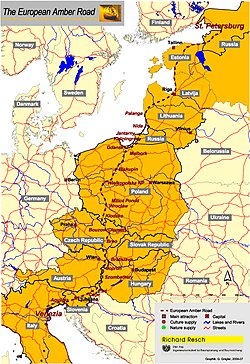Amber Road
Sicilian amber was also discovered in Mycenae by the archaeologist Heinrich Schliemann, and it appeared in sites in southern Spain and Portugal.
Its distribution is similar to that of ivory, so it is possible that amber from Sicily reached the Iberian Peninsula through contacts with North Africa.
[7] The quantity of amber in the Royal Tomb of Qatna, Syria, is unparalleled among known second millennium BC sites in the Levant and the Ancient Near East.
[11][12] In Scandinavia the amber road probably gave rise to the thriving Nordic Bronze Age culture, bringing influences from the Mediterranean Sea to the northernmost countries of Europe.
The shortest (and possibly oldest) road avoids alpine areas and led from the Baltic coastline (nowadays Lithuania and Poland), through Biskupin, Milicz, Wrocław, the Kłodzko Valley (less often through the Moravian Gate), crossed the Danube near Carnuntum in the Noricum province, headed southwest past Poetovio, Celeia, Emona, Nauportus, and reached Patavium and Aquileia at the Adriatic coast.
The Swiss region indicates a number of alpine roads, concentrating around the capital city Bern and probably originating from the banks of the Rhône and Rhine.
A small section led southwards from Antwerp and Bruges to the towns Braine-l'Alleud and Braine-le-Comte, both originally named "Brennia-Brenna".



